Sourdough Bread Recipe
This basic Sourdough Bread Recipe produces an artisan loaf with a crisp crust and chewy crumb. It is best baked in a Dutch oven, but the recipe is very flexible and adaptable.
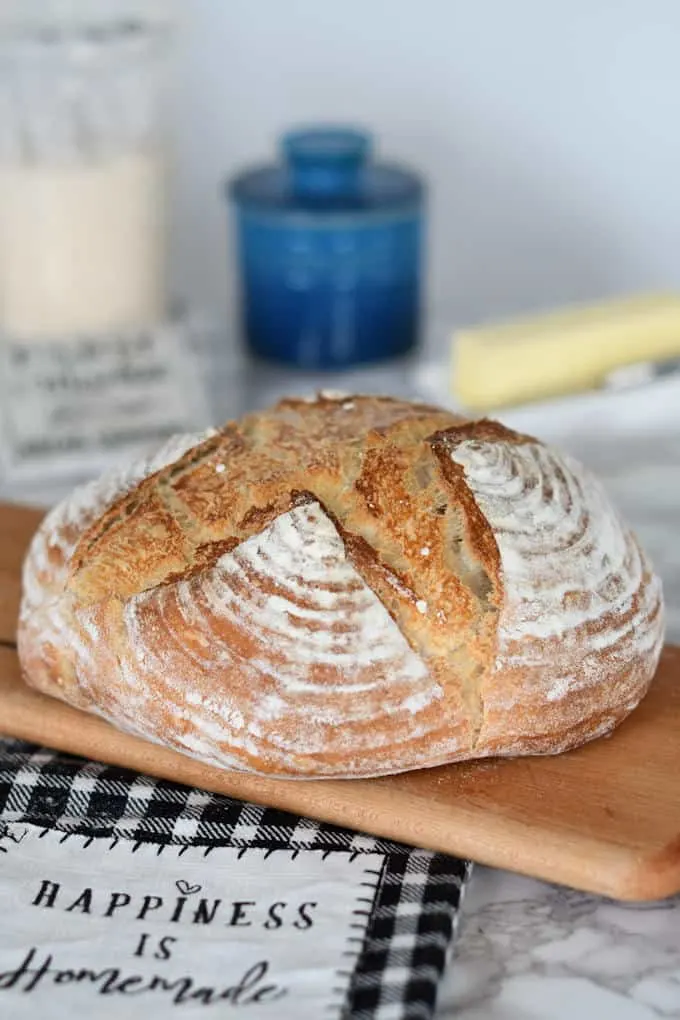
I think that this recipe for crusty sourdough bread is reason enough for making a sourdough starter. The wild yeast in sourdough starter makes an exceptionally delicious loaf of bread.
Because the bread freezes really well, I make a loaf of this Sourdough Bread each time I need to feed my sourdough starter.
What is Sourdough Bread?
Any bread that you make with a sourdough starter is a “sourdough” bread. There are a few key steps that will produce a light, crusty and chewy bread that is the quintessential loaf we all imagine when we hear “artisan sourdough bread ” .
What does the “hydration” percent mean for sourdough starter?
Hydration percent means the ratio of water to flour used for feeding your starter. If you feed your starter with equal weights of flour and water then your starter is 100% hydration. If you feed your starter with twice as much flour as water the hydration level is 50%.
Ingredients
- Active sourdough starter (100% hydration)
- Warm water
- Unbleached all purpose flour
- Salt
How to make Sourdough Bread
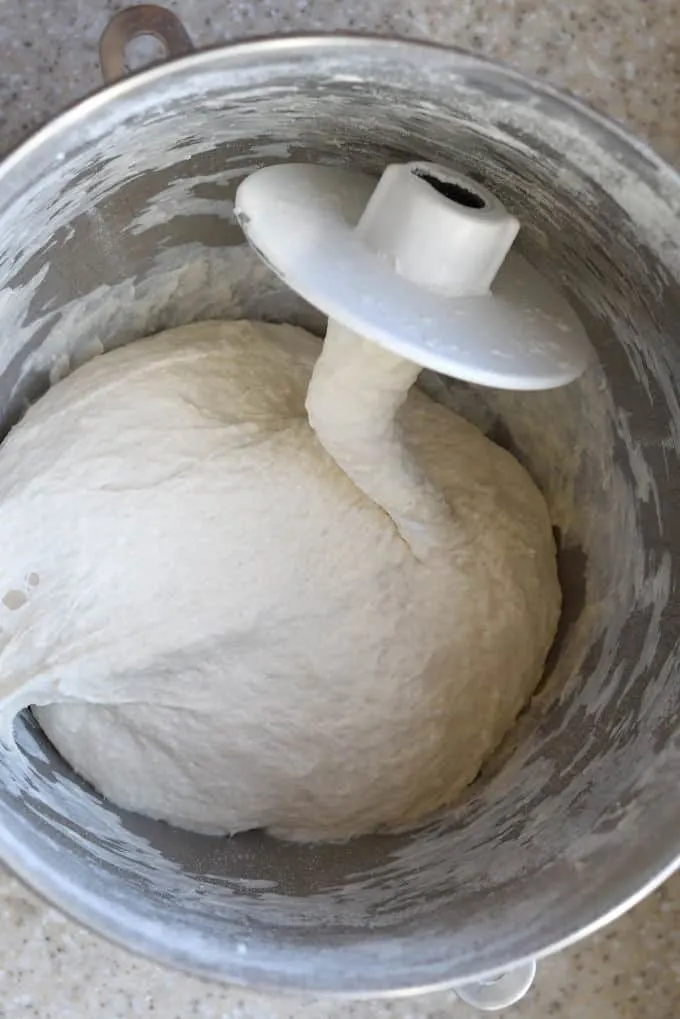
- The dough can be mixed by hand or on a stand mixer.
- The dough starts our quite sticky but will become more cohesive as it ferments.
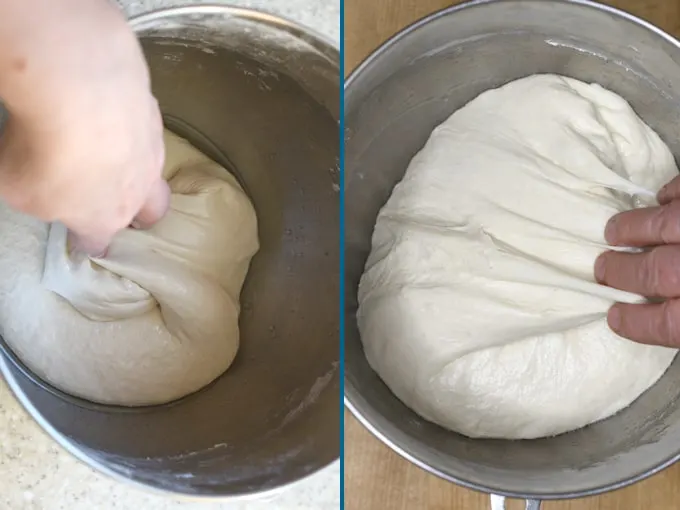
- Stretch and fold the dough several times during the initial fermentation.
- The dough will become more lively and aerated as it ferments.
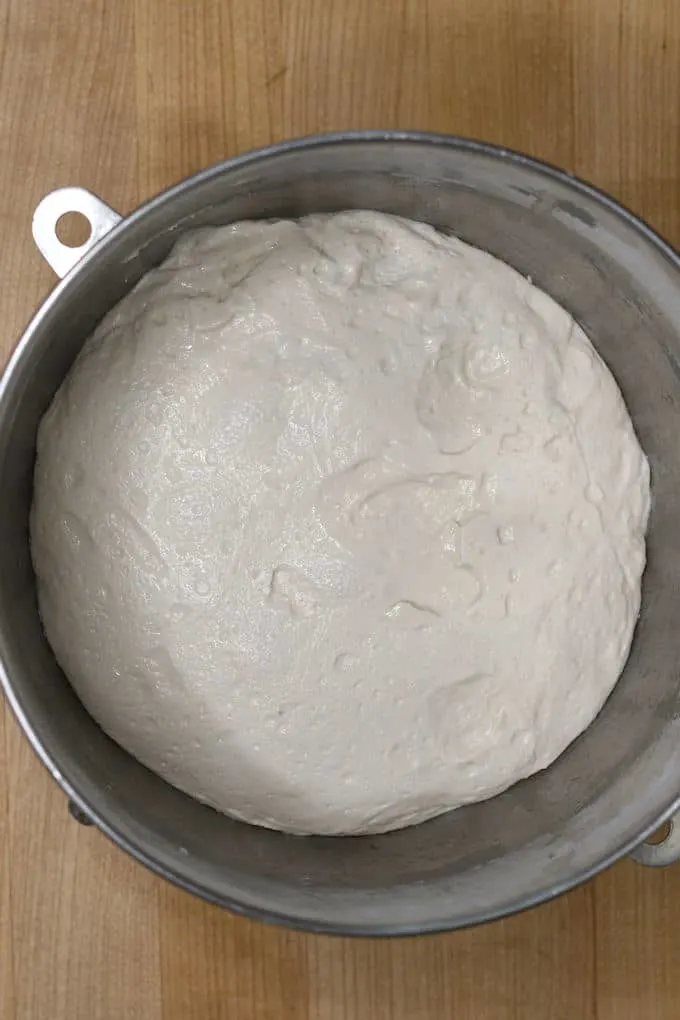
- Refrigerate the dough overnight. The dough can be refrigerated for up to 2 days.
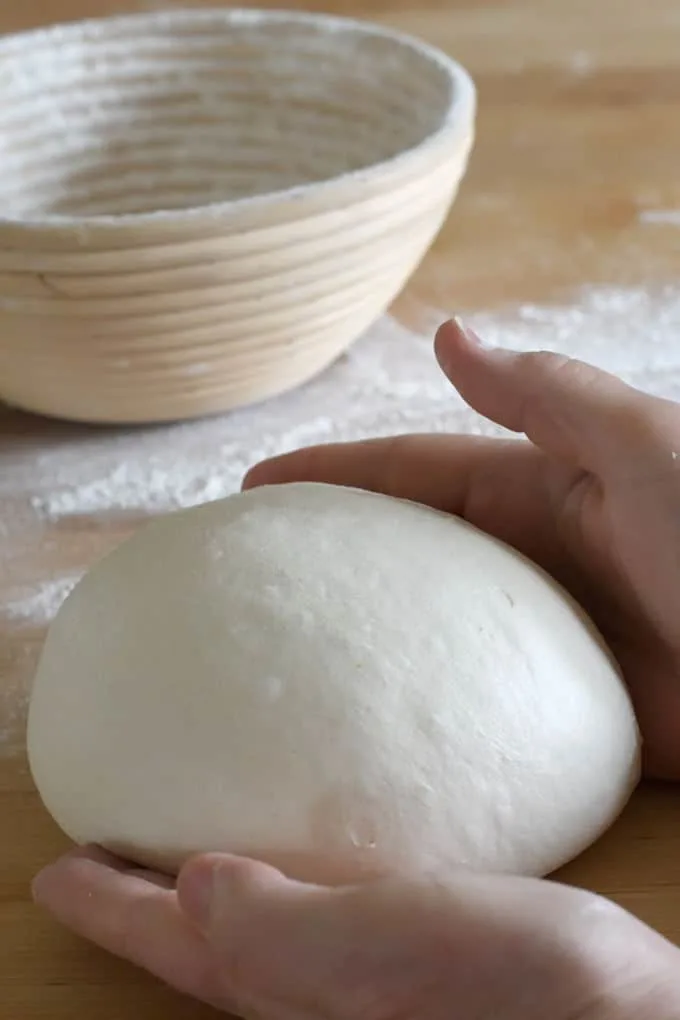
- Turn the dough out onto a lightly floured surface.
- Use cupped hands to form the dough into a smooth ball.
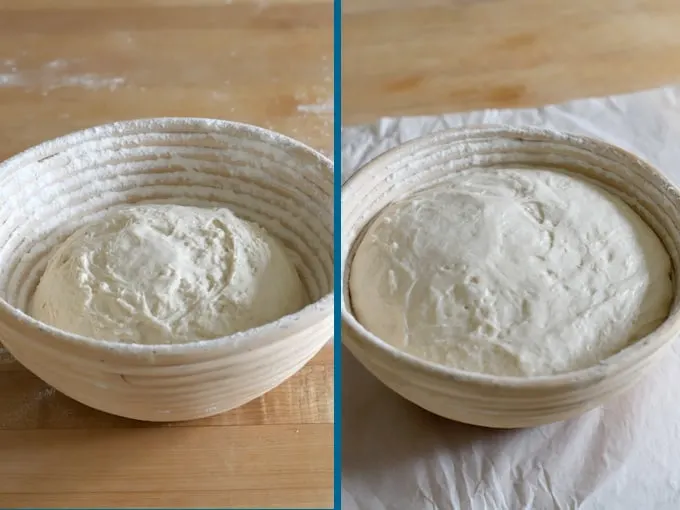
- Set the dough aside to rise for 2-3 hours until it doubles in size. The exact rise time will depend on the temperature of the dough and the ambient temperature.
- If you don’t have a proofing basket you can put the dough directly onto a piece of parchment paper for rising.
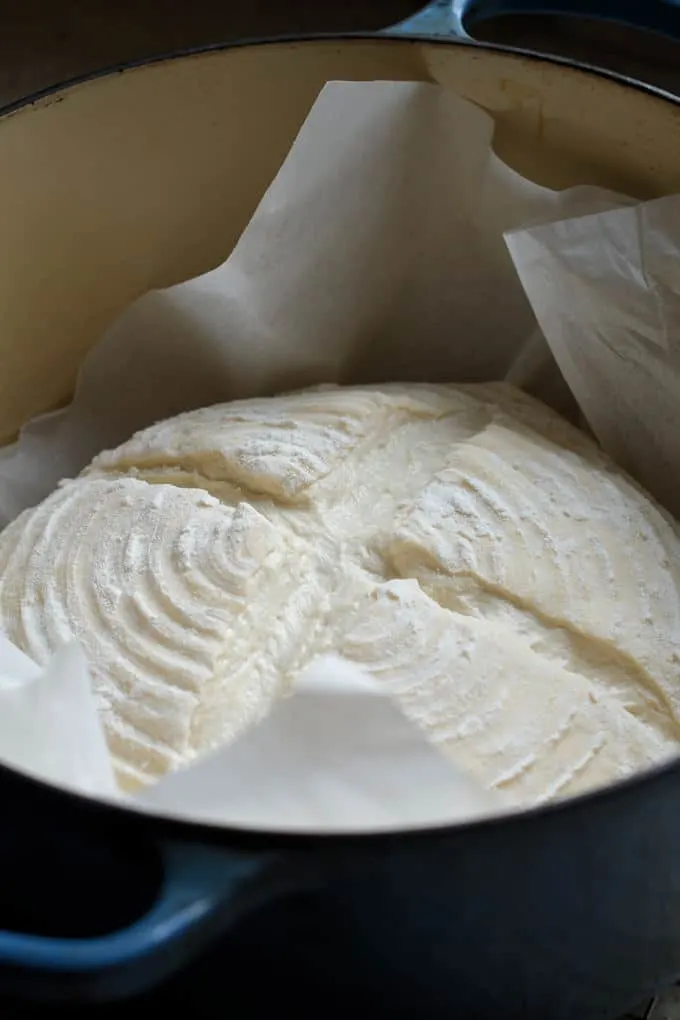
- Flip the loaf onto a piece of parchment paper, score the top, then use the paper to lower the loaf into the preheated Dutch oven.
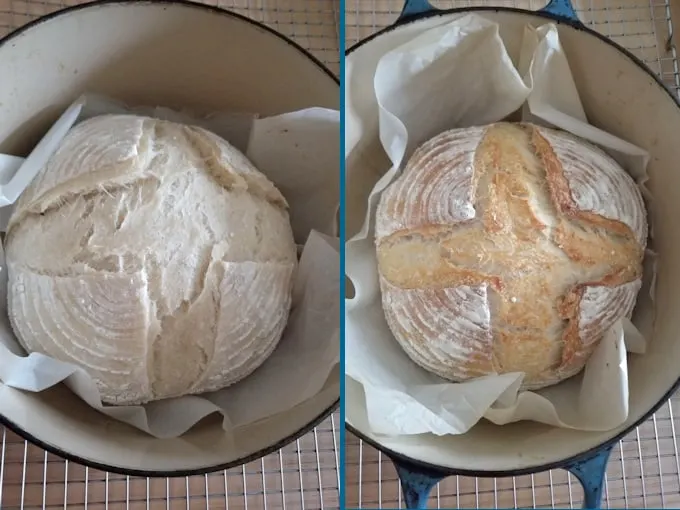
- After 20 minutes baking the loaf is well-risen but still pale.
- Remove the lid and continue baking another 20 minutes until the loaf is golden brown.
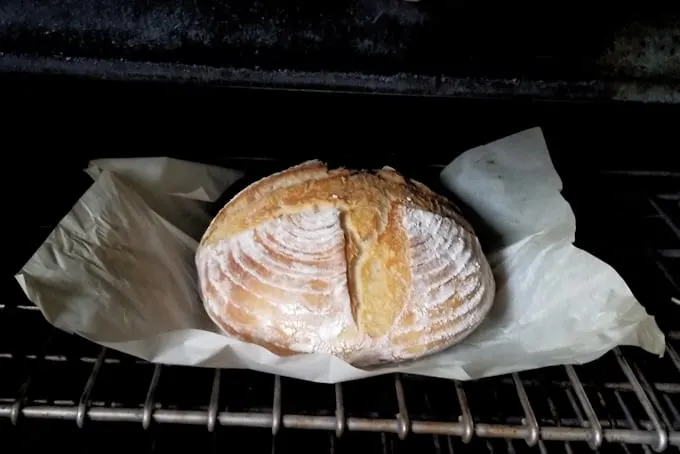
- Remove the loaf from the Dutch oven.
- If the crust is not quite brown enough you can return the loaf to the oven to finish baking until deeply golden brown and very crisp.
Timeline for making sourdough bread:
- If your starter needs feeding, do that the night before or early in the morning of the day you want to make the dough.
- Mix the dough in the afternoon. Allow it to ferment at room temperature all day and refrigerate the dough in the evening before going to bed.
- The dough can stay in the refrigerator for 2-3 days at this point.
- Take the dough out first thing in the morning and shape the loaf.
- Leave the loaf at room temperature to rise for 1 1/2- 2 hours.
- You should have fresh bread by lunch time.
Pastry Chef tips for making artisan Sourdough Bread at home
- A wet dough is a sticky dough and can be a bit fussy to handle. Because this bread has a long, slow fermentation, the bread has time to develop plenty of gluten without lots of kneading.
- The more lively and active your starter is, the better loaf you’ll produce. Use your starter after it’s been fed and just before it’s reached it’s peak rise.
- If you are working with a starter that is not 100% hydration you’ll need to adjust the amount of flour/water in the dough to allow for the difference.
- The Dutch oven creates a moist environment that develops that thick, crispy crust on the bread. Any oven-safe, heavy pot with a lid will work if you don’t have a Dutch oven.
FAQs for making sourdough bread at home:
Yes, start the dough early in the morning and skip the refrigeration step.
You can proof the dough right on the parchment paper that will go into the Dutch Oven.
Use any heavy, oven-safe pot with a lid, or slide the parchment onto a sheet pan to bake. The crust might not be quite as crisp as it is when baked in a Dutch oven.
You could try and shape this dough into a baguette. But I suggest you try this recipe for Sourdough Baguettes instead.
The bread keeps for 2-3 days at room temperature.
Yes! Store the loaf or slices in a freezer bag for up to 3 months.
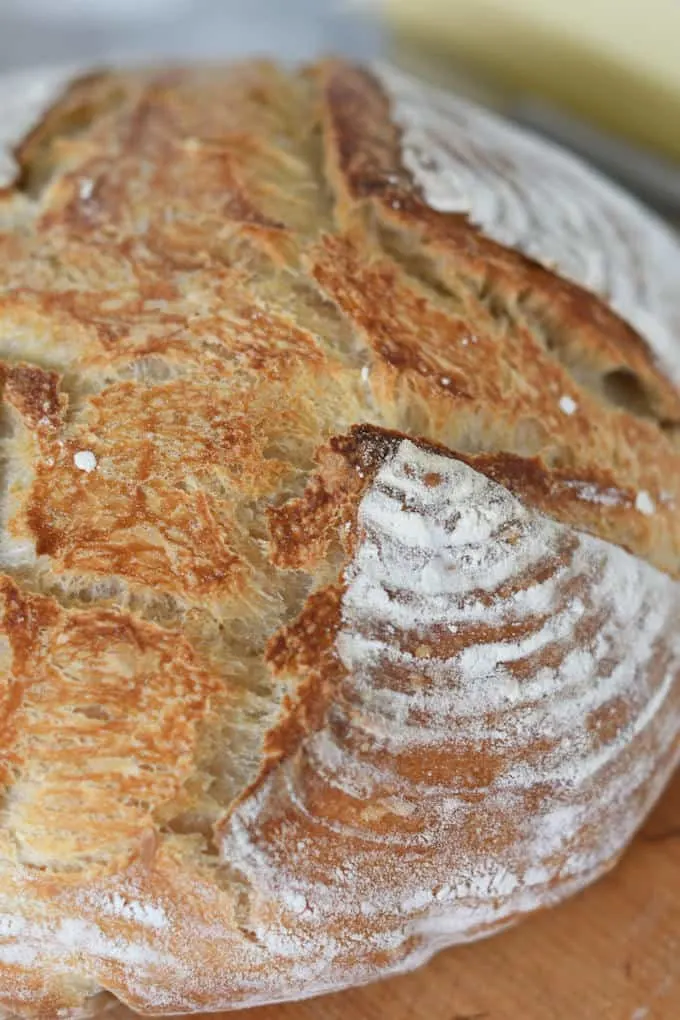
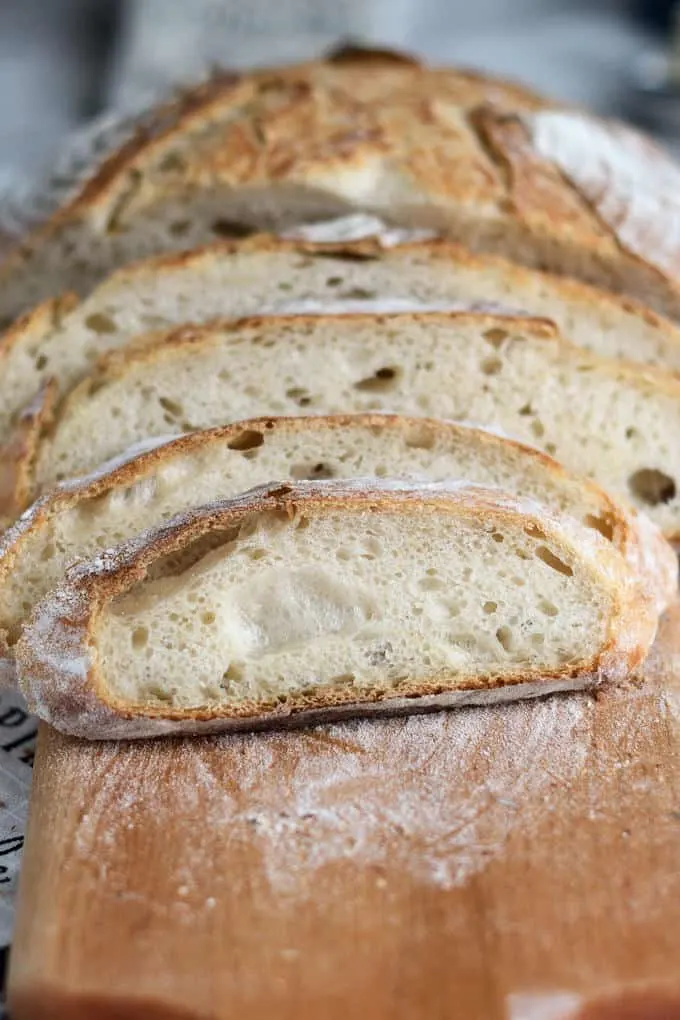
I know you hate to throw away that sourdough discard. Check out these recipes that use sourdough discard.
If you want to make a loaf with the crispiest crust ever, try making Sourdough Semolina Bread.
If you love this recipe as much as I do, I’d really appreciate a star rating and a quick comment. Ratings and comments help my recipes show in search results. Thanks!
Artisan Sourdough Bread Recipe
Ingredients
- 8 ounces active sourdough starter (1 cup (100% hydration))
- 8 ounces warm water (1 cup)
- 12 ½ ounces unbleached all purpose flour (2 ½ cups, see note)
- 1 ½ teaspoons table salt
- Rice flour for proofing basket
Instructions
- Combine 8 ounces active sourdough starter, 8 ounces warm water and 1 ½ cups (7 ½ oz) of the flour. Mix with the paddle on low speed until it forms a thick batter. Cover the bowl and set aside for 30-60 minutes.
- If using a stand mixer, change to the dough hook. Add 1 ½ teaspoons table salt and the rest of the flour and mix until the dough begins to form a ball around the hook. If mixing by hand add the flour using a wooden spoon and/or a plastic bowl scraper. This dough is quite sticky.
- Place the dough into a lightly oiled bowl, turn once to coat the dough. Cover the bowl and set it aside at room temperature.
- After 60 minutes uncover the bowl, lift one side of the dough and fold it into the middle of the dough. Repeat with the other three sides of the dough then flip the dough over. You're basically turning the dough inside-out to redistribute the yeast. Cover the bowl and every hour or so repeat the procedure.
- After about 2 hours the dough should be lively, elastic and airy. If the dough is still sluggish give it another hour or two at room temperature. Cover tightly and refrigerate overnight.
- Remove the dough from the refrigerator and dump it onto floured surface. Without kneading, use your cupped hands to form the dough into a smooth ball. Cover lightly with a kitchen towel or plastic wrap and let the dough rest for 20-30 minutes. If the ball flattens during the 20 minutes fold it onto itself and form the ball again. This step will help you check if your dough is elastic enough to help it’s shape during the final rise and baking.
- Uncover the dough and knead 1-2 times. Reshape the dough into a smooth ball and place the dough into a well-floured proofing basket (I use a mix of ½ rice flour and ½ all purpose flour in the basket) or directly onto a sheet of parchment paper.
- Cover the dough and leave in a warm place until it's almost doubled in size and it springs back slowly when poked, about 2 hours depending on the room temperature and dough temperature. Meanwhile, preheat the oven to 425°F. Place a Dutch oven with a lid into the oven to preheat.
- If the loaf is in a proofing basket, place a sheet of parchment over the dough and gently flip it over. Use a single edge razor or very sharp knife to cut a ¼" deep X across the top of the loaf. Remove the preheated pan from the oven and remove the lid. Use the parchment to lift the loaf into the Dutch oven.
- Replace the lid on the pot and slide it into the oven. Bake for 20 minutes. Remove the lid from the Dutch oven. The loaf should be well risen and pale in color.
- Continue baking another 20 minutes until the loaf is nicely browned and beginning to crisp. Remove the pan from the oven. Use the parchment to lift the loaf out of the pan. Use the parchment to place the loaf directly onto the rack in the oven. Bake another 5-10 minutes until the loaf is deeply browned and very crisp. Total baking time is about 40-50 minutes.
- Cool completely on a wire rack before slicing.
Would you like to save this recipe?
As an Amazon Associate and member of other affiliate programs, I earn from qualifying purchases.

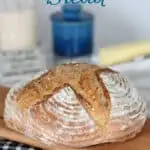
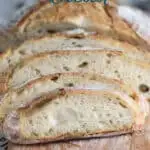
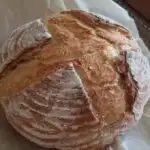





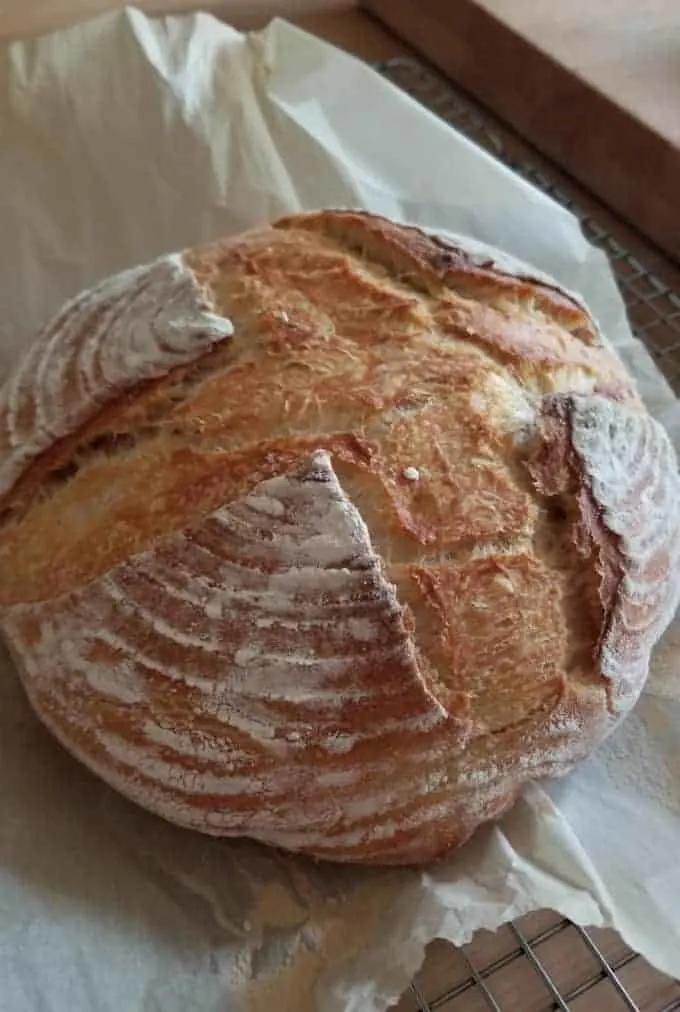
I grew my own starter and have just started making sourdough bread this spring. This is the 4th and best recipe I have tried. It turned out so perfectly! I am going to try your sourdough rye recipe next.
Great bread, thank you! I am trying to figure out why when I measure out 8 oz of starter for the recipe, I do not have 4 oz left over to put back in the fridge. This has happened to me both times. The first time I had just over an ounce left, and this time I have 3.5 ounces. Does it have to do with when I take the starter? The first time I think I used the starter a bit late, it had gone a little watery. This time I think I got it when it doubled and it was much thicker.
As long as you are weighing it shouldn’t matter what the texture of the starter is. That is why weighing is the most accurate way to measure. 8 oz is always 8 oz. I would say it might be the way you are feeding the starter. If you’re not weighing for the feedings the starter will have a different weight to start with.
Thank you. I always weigh everything at every step – which is why it is so odd. Conservation of mass should apply. I can’t figure it out.
Yes, that is very strange. If you start with 4 oz of starter and add 4 oz of water and 4 oz of flour you will have 12 oz total no matter how much the starter rises or falls. When you say you are measuring 8 oz do you mean you are measuring with a scale, not a measuring cup? 8 oz of liquid measure can vary, but 8 oz on a scale is 8 oz.
Measuring with a scale! It is very odd indeed!
Hi there. I’ve tried this recipe 2 times now and second time better than the first, however my bread doesnt rise. It’s not rising much during step 8 or in the oven much. It comes out tasting good and sour but its dense and not airy at all. Any thoughts on what I am doing wrong? I have pictures but not sure how to share.
Sounds like maybe your starter is not active enough. Do you feed with within a couple of hours of mixing the dough? Is the dough nice and light after the long fermentation?
I am having a similar issue. My starter rises well, but the dough just isn’t rising after the overnight fermentation or in the oven. Four times I have tried – first was awful, send and third gradually better, and fourth terrible. I have left it out for hours in the morning to try and get it to double in size, but it barely rises at all.
How does it do during the fermentation? Is is changing from sticky and slack to bouncy and lively? How long before making the dough are you feeding your starter?
Hi Eileen! Thank you so much for sharing! I am in the beginning stages (day 4 and so far so good!) On my starter. But noticed in the recipe it calls for table salt. In your opinion, If I use sea salt or kosher would I use an equivalent weight or same measurement as the table salt?
If you use something other than table salt you should weigh the salt. The same volume of larger-grain sea salt or kosher salt will weigh less than table salt. I use table salt for baking because any nuance in flavor from sea salt or other specialty salts would be lost. If you don’t have table salt in the house use what you have, but you’ll need to weigh to account for the size of the salt grain. Here’s a post all about salt which includes a table of different salts and how the weight can vary.
Learning how to bake sourdough bread from your website has been so gratifying and fun these past few months..working from home.
I will never enjoy store bought bread again after having mastered (a little) your delicious bread recipes. Thank you.!
Melissa
Thanks so much, Melissa. Once you get the hang of it you realize that baking bread isn’t really that much work. I hope you keep it up when you go back out to work away from home.